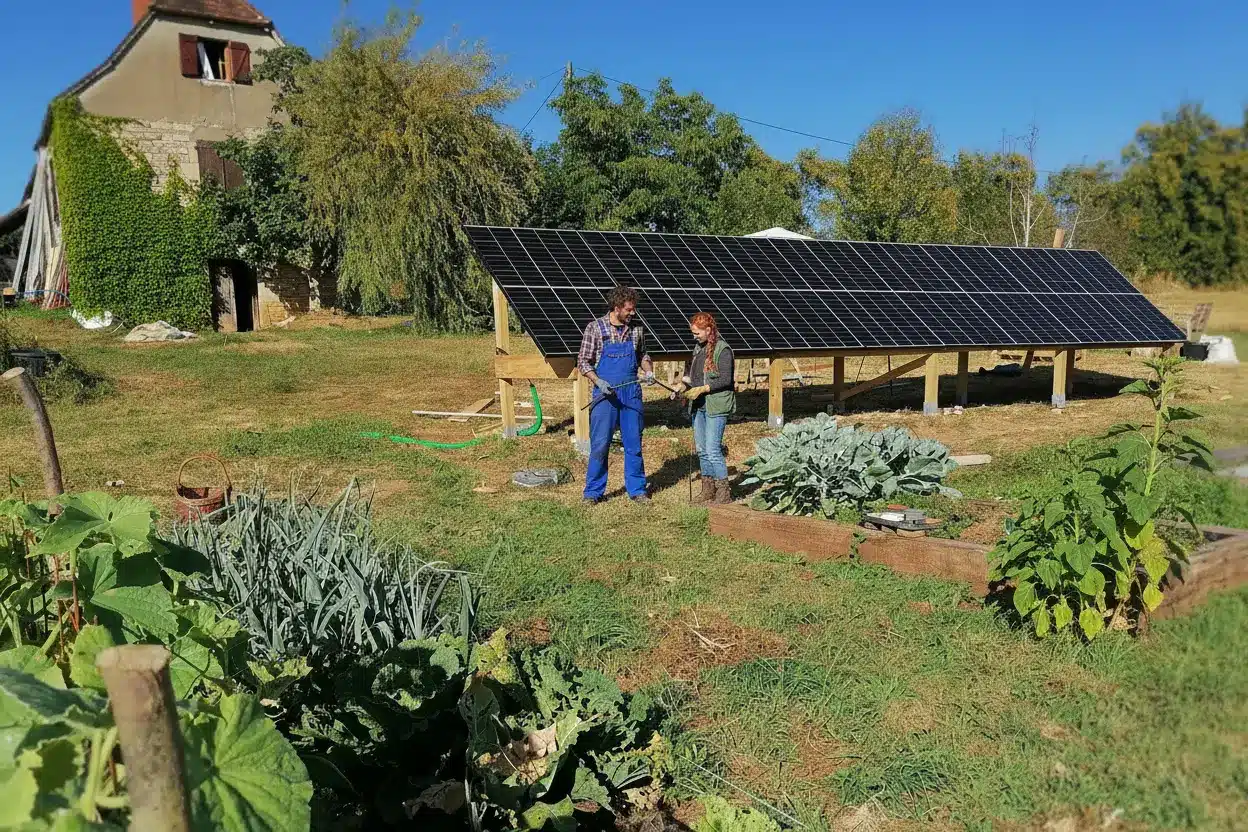What if slashing your electricity bills was just a matter of rolling up your sleeves and taking on the sun? Audren Van Zalk, a seasoned builder and self-confessed DIY enthusiast, proved just that by constructing his own solar power station in the French countryside within a matter of days. No waiting lists, no mountains of paperwork—just ingenuity, elbow grease, and a keen desire to flip the switch on energy independence.
Going Solar in Just Days: Audren’s Ambitious Project
Forget what you’ve heard about installing solar panels being an endless saga of dust and headaches. In a small town in the department of Lot, Audren built his own photovoltaic farm in little more than a couple of weekends. « It took me a big weekend for the wooden structure and another weekend for setting up the panels, » says Audren, who’s spent the last two decades working in the construction sector.
In the rolling countryside of his backyard, he installed a 3.2 kWc photovoltaic station—clipped to 3 kWc by the inverter (respecting Enedis regulations) for self-consumption with any excess injected into the public grid free of charge. Eight 400 Wc panels rest on a sturdy wooden frame that Audren not only designed but also built himself. If you’re curious and looking for a step-by-step playbook, he details it all on his social accounts, aptly named “Objectif ZeroCarbone.”
Chasing Efficiency on a Budget
This wasn’t some teenage whim—Audren had dreamed of harnessing renewable energy at home since he was 15, although city living kept those plans on hold. But with energy prices on the rise and the looming end of the tariff cap in 2024, he seized the technical challenge head-on. Despite his background in electrical work, Audren took the time to brush up on everything specific to photovoltaics before ordering €2,200 in gear—which included the panels, a 5 kW inverter, and both AC/DC junction boxes, delivered to his door. Add €250 for the wooden structure, €150 for the grounding wire, and a hundred euros for hardware, and he spent a grand total of €2,700.
At €844 per kWc, that’s a serious bargain, especially compared to professional installations that can run between €1,500 to €3,000 per kWc. By doing it himself, Audren scored significant savings. And if he isn’t using the solar electricity right away? The surplus is injected into the public grid gratis—an administrative shortcut that saves on paperwork, since getting paid for surplus requires strict technical approvals and a green light from the Consuel.
Making the Most of Solar: Smart Priorities and Manual Tricks
A savvy home energy manager, Audren could have gone the domestic battery route for extra efficiency, letting him store solar juice day or night—even when the skies are decidedly non-solar. But he had a better plan. “I didn’t opt for a battery because my electric car—a Renault Zoé 22 kWh—soaks up much of the production,” he explains. Instead of disappearing into the grid, surplus electricity recharges his vehicle. “A battery would have doubled the cost of the installation and significantly pushed back the pay-off time,” he adds on Twitter.
Other heavy lifters in Audren’s electric home include a water heater and, soon, an air-to-air heat pump. At present, he manually directs power to these devices (with smart plugs, no less). “When I know the weather will be good or see excess power going to the grid, I trigger them manually,” Audren says. He does plan to install load-shedding devices soon, to let automation take over from his keen eye.
- Electric car charging: Twin wins of mobility and energy storage
- Manual power distribution: Smart-plug precision at his fingertips
- Future-proofing: Load-shedding devices are on the horizon
Upgrades, Orientation, and Long-Term Savings
Audren’s not following the crowd on sunbathing technique either. While most solar stations face due south, Audren has tilted his panels slightly west. “I need more energy in the evening, so I optimized for my usage,” he explains. This positioning boosts output in late afternoons, sacrificing faster power-ups in the mornings. He aims to generate about 3,200 kWh of photovoltaic electricity a year—most of which will power his Renault Zoé, which draws 2,000 kWh annually. The remaining 1,200 kWh helps the family cover around 25% of their household’s annual 11 MWh usage. With his heat pump and a future system to control the station, Audren expects to cut household usage to 6 MWh, bumping solar coverage to about 50%.
His energy-hungry, 200-year-old stone house—90 m² and home to three people—is warmed by a wood stove and a soon-to-be-installed reversible heat pump, which will replace the current electric « toaster » radiators. Everything runs on electricity. “I hardly use any hydrocarbons anymore,” he boasts.
Audren’s electricity bill currently hovers around €200 per month. He estimates yearly savings of €450 from his solar production alone. So, the solar station should theoretically pay for itself within about five years—excluding the wooden frame, which, as he puts it, “is also an indispensable woodshed!”
The takeaway? With determination, a solid grasp of the technical, and a dash of DIY spirit, breaking (solar) ground on your own energy independence is hands-on, achievable, and seriously cost-effective. Plus, you get to brag that your woodshed is moonlighting as a powerhouse. Not a bad conversation starter at the next neighborhood barbecue.

John is a curious mind who loves to write about diverse topics. Passionate about sharing his thoughts and perspectives, he enjoys sparking conversations and encouraging discovery. For him, every subject is an invitation to discuss and learn.






